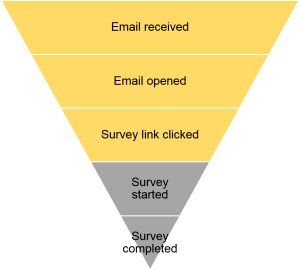Survey Administration Best Practices: Sending Invitation and Reminder Messages
Since 2000, Ithaka S+R has run the US Faculty Survey, which tracks the evolution of faculty members’ research and teaching practices against the backdrop of increasing digital resources and other systemic changes in higher education. Starting in 2012, Ithaka S+R has offered colleges and universities the opportunity to field the faculty survey, and a newly added student survey, at their individual institutions to gain better insight into the perceptions of their faculty members and students. More than 70 local faculty and student surveys have been fielded thus far and have enhanced Ithaka S+R’s expertise in higher education survey administration.
This post is the third in a series on survey administration best practices. Ithaka S+R is often queried about our survey administration processes, and this series of blog posts explores both our experience in fielding surveys and current research from email marketers. Before reading this blog post, you may want to start from the beginning of the series with learning how to ensure your survey invitation is received and opened.
After crafting an email that will entice the recipient to click on the link to your survey, you need to determine when to send it and how many reminder messages will help ensure a high response rate.

The number of participants who start and complete the survey are dependent on these preliminary steps. Maximizing the number of recipients who open the email and click on the survey link will, in turn, help to increase the response rates.
The following recommendations will help you determine a communications strategy for sending invitation and reminder messaging. These recommendations should be interpreted in the context of both the sender and the recipient of the communication, as your experiences may vary depending on these factors.
When should I send the survey invitation?
First, you should think about the audience you are trying to reach. What is a typical week like for them? When might they be most likely to open your message? And, when will they have enough time to complete the survey once they have opened your message? Most recipients will decide whether or not to start the survey immediately after opening and reading your message, so it is important to send your invitation at a time when they will have an opportunity to complete the survey immediately.
Within the higher education context, Ithaka S+R has found that sending survey invitations on Monday morning is the most effective for faculty members and students.
If you are interested in testing if this time is most effective for your survey, you can perform A/B testing by splitting up your survey distribution into two or more different groups. You should keep all other aspects of the messaging consistent, including the content of the message, the signatory, and the subject line, but send the distributions separately on different days and times to see which is more effective in increasing email open rates, survey click rates, and survey completion rates.
Once the invitation has been distributed, you should monitor when individuals are taking the survey to determine when to send reminder messaging, based on the actual behavior of your respondents.
When should I send reminders and how many reminders should I send?
Reminders offer an opportunity for you to reach those recipients who didn’t notice or open the survey invitation, or did open it but didn’t have time to complete the survey. In sending reminder messages, you should do so at different times than when you sent the invitation to increase your odds of at least one email arriving at the right time for each of your respondents. If you send the reminder messaging at the same as the original invitation, it is unlikely that you will capture a new audience; people tend to have the same habits around checking email from week to week.
Ithaka S+R has found that sending 2-3 reminders for a survey that is open for a period of approximately 4-6 weeks is optimal for achieving a high response rate, but not irritating your recipients with too many rounds of communication. We typically will send reminder messages Tuesday through Thursday in the late morning or early afternoon, as we have seen the highest levels of response to our messaging during these times. We have found that Friday tends to be the least effective day of the work week for reminder and invitation messages.
It is important that you either provide a way for respondents to unsubscribe to these communications (with an unsubscribe link in the emails, for example) or actively monitor the replies to these communications and remove those individuals who would like to opt out. More generally speaking, you should always monitor replies to the invitation and reminder messaging to field questions and concerns and gather feedback from your respondents.
Following the recommendations above with your audience in mind will ultimately help you increase the response rates to your survey – and, if your audience needs additional motivation to complete the survey, offering an incentive for participation may be beneficial. In my next blog post, on incentives and how they can be used appropriately to motivate respondents to complete your survey.